Level 3 Teaching: Health and Safety in Educational Environments Report
VerifiedAdded on 2022/08/16
|14
|4579
|15
Report
AI Summary
This report addresses key aspects of health and safety within educational settings, focusing on Level 3 teaching requirements. It begins by identifying relevant legislation, such as the Health and Safety at Work Act 1974, and emphasizes the responsibilities of educators in ensuring a safe learning environment. The report then details factors to consider when planning both indoor and outdoor activities, including staff-to-pupil ratios, environmental conditions, and material safety. It outlines methods for monitoring and maintaining health and safety through policies, staff training, and risk assessments. A significant portion of the report is dedicated to risk assessment, demonstrating how to identify potential hazards and implement control measures. Furthermore, it explores the importance of a balanced approach to risk management, considering both the dangers and the benefits of activities. The report also examines the dilemma between children's rights and safety requirements, highlighting the educator's role in fostering independence while managing risks. Finally, the report includes a reflection on the author's practice, describing how they support children in assessing and managing risks within various activities.
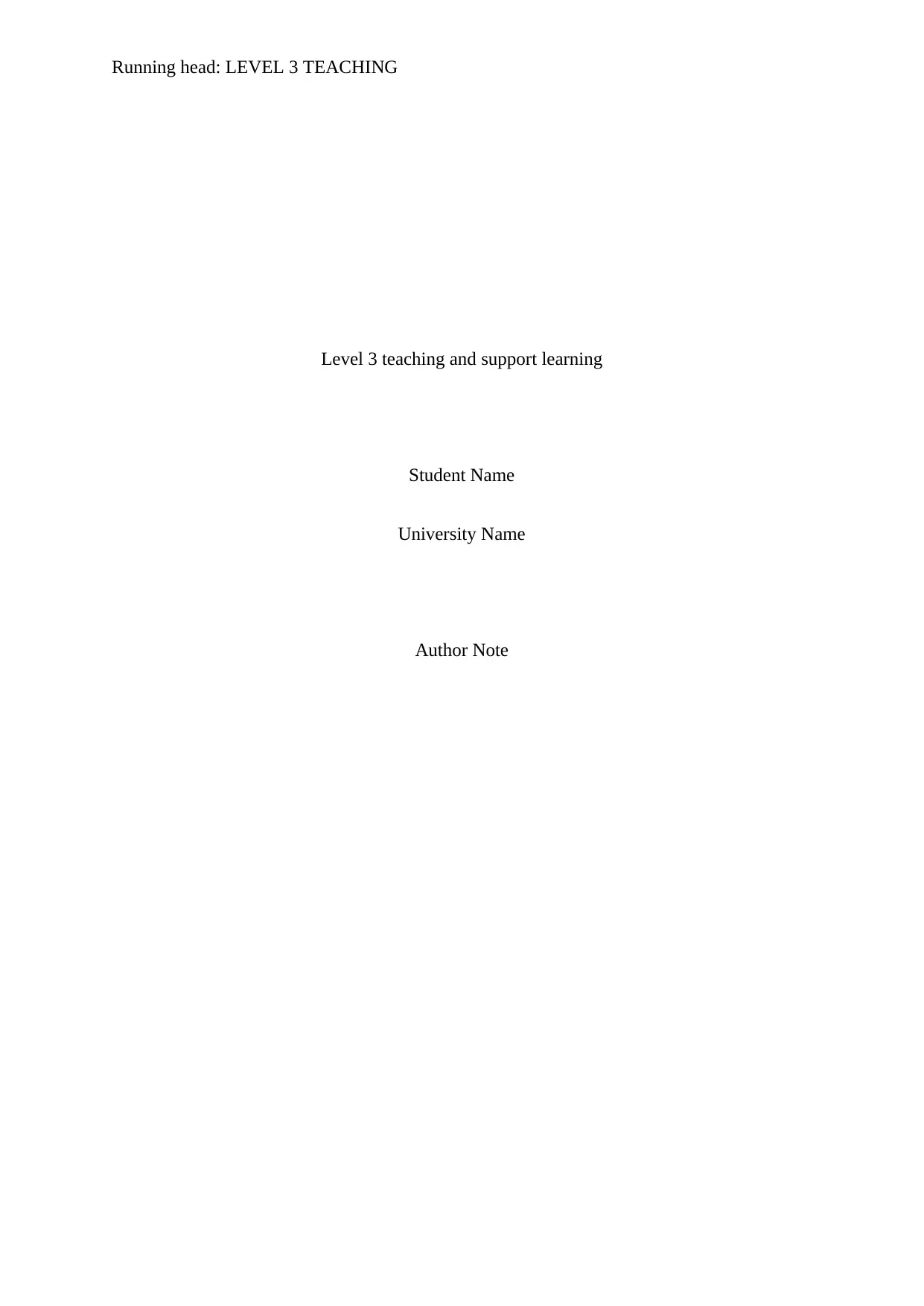
Running head: LEVEL 3 TEACHING
Level 3 teaching and support learning
Student Name
University Name
Author Note
Level 3 teaching and support learning
Student Name
University Name
Author Note
Paraphrase This Document
Need a fresh take? Get an instant paraphrase of this document with our AI Paraphraser
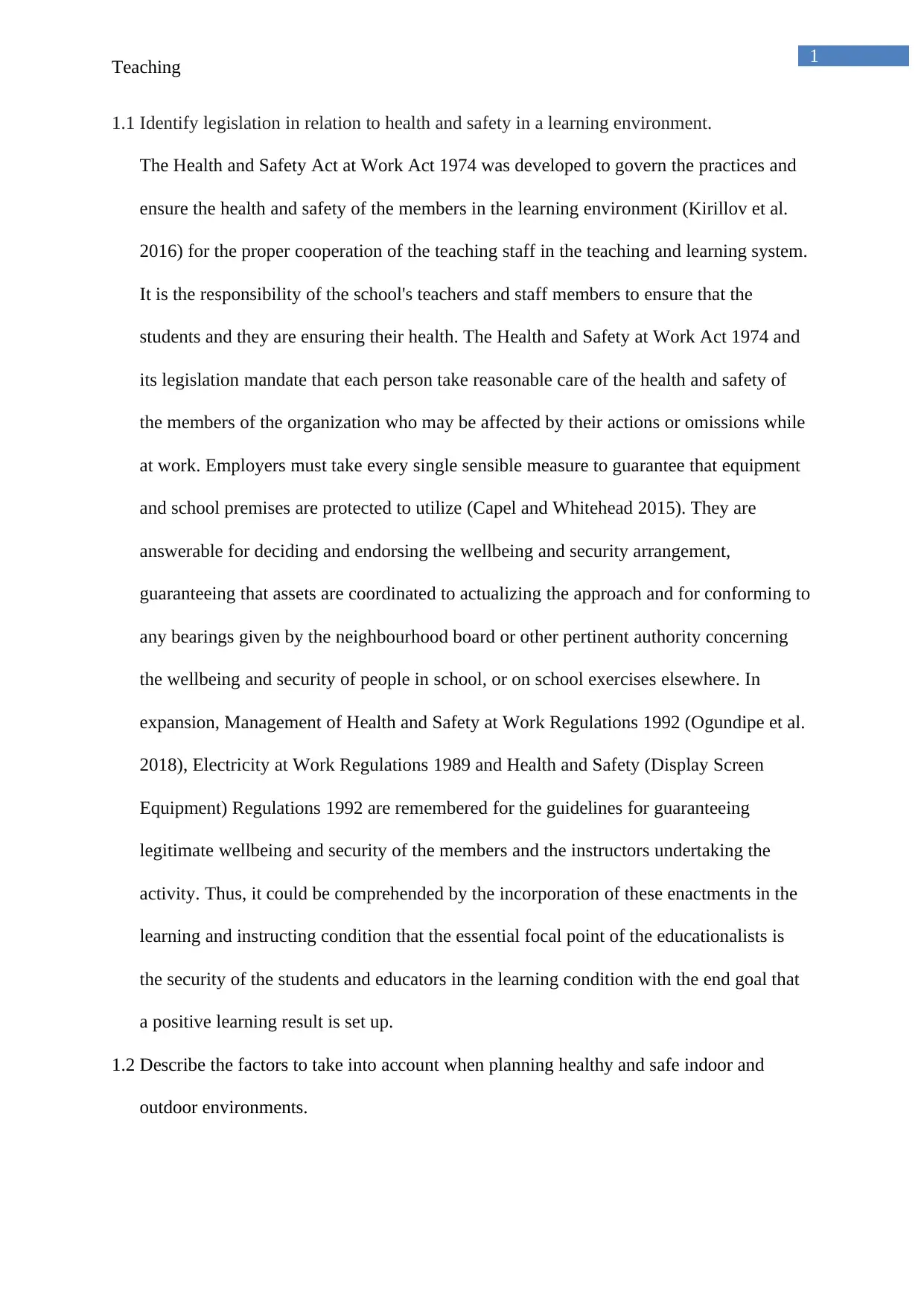
1
Teaching
1.1 Identify legislation in relation to health and safety in a learning environment.
The Health and Safety Act at Work Act 1974 was developed to govern the practices and
ensure the health and safety of the members in the learning environment (Kirillov et al.
2016) for the proper cooperation of the teaching staff in the teaching and learning system.
It is the responsibility of the school's teachers and staff members to ensure that the
students and they are ensuring their health. The Health and Safety at Work Act 1974 and
its legislation mandate that each person take reasonable care of the health and safety of
the members of the organization who may be affected by their actions or omissions while
at work. Employers must take every single sensible measure to guarantee that equipment
and school premises are protected to utilize (Capel and Whitehead 2015). They are
answerable for deciding and endorsing the wellbeing and security arrangement,
guaranteeing that assets are coordinated to actualizing the approach and for conforming to
any bearings given by the neighbourhood board or other pertinent authority concerning
the wellbeing and security of people in school, or on school exercises elsewhere. In
expansion, Management of Health and Safety at Work Regulations 1992 (Ogundipe et al.
2018), Electricity at Work Regulations 1989 and Health and Safety (Display Screen
Equipment) Regulations 1992 are remembered for the guidelines for guaranteeing
legitimate wellbeing and security of the members and the instructors undertaking the
activity. Thus, it could be comprehended by the incorporation of these enactments in the
learning and instructing condition that the essential focal point of the educationalists is
the security of the students and educators in the learning condition with the end goal that
a positive learning result is set up.
1.2 Describe the factors to take into account when planning healthy and safe indoor and
outdoor environments.
Teaching
1.1 Identify legislation in relation to health and safety in a learning environment.
The Health and Safety Act at Work Act 1974 was developed to govern the practices and
ensure the health and safety of the members in the learning environment (Kirillov et al.
2016) for the proper cooperation of the teaching staff in the teaching and learning system.
It is the responsibility of the school's teachers and staff members to ensure that the
students and they are ensuring their health. The Health and Safety at Work Act 1974 and
its legislation mandate that each person take reasonable care of the health and safety of
the members of the organization who may be affected by their actions or omissions while
at work. Employers must take every single sensible measure to guarantee that equipment
and school premises are protected to utilize (Capel and Whitehead 2015). They are
answerable for deciding and endorsing the wellbeing and security arrangement,
guaranteeing that assets are coordinated to actualizing the approach and for conforming to
any bearings given by the neighbourhood board or other pertinent authority concerning
the wellbeing and security of people in school, or on school exercises elsewhere. In
expansion, Management of Health and Safety at Work Regulations 1992 (Ogundipe et al.
2018), Electricity at Work Regulations 1989 and Health and Safety (Display Screen
Equipment) Regulations 1992 are remembered for the guidelines for guaranteeing
legitimate wellbeing and security of the members and the instructors undertaking the
activity. Thus, it could be comprehended by the incorporation of these enactments in the
learning and instructing condition that the essential focal point of the educationalists is
the security of the students and educators in the learning condition with the end goal that
a positive learning result is set up.
1.2 Describe the factors to take into account when planning healthy and safe indoor and
outdoor environments.
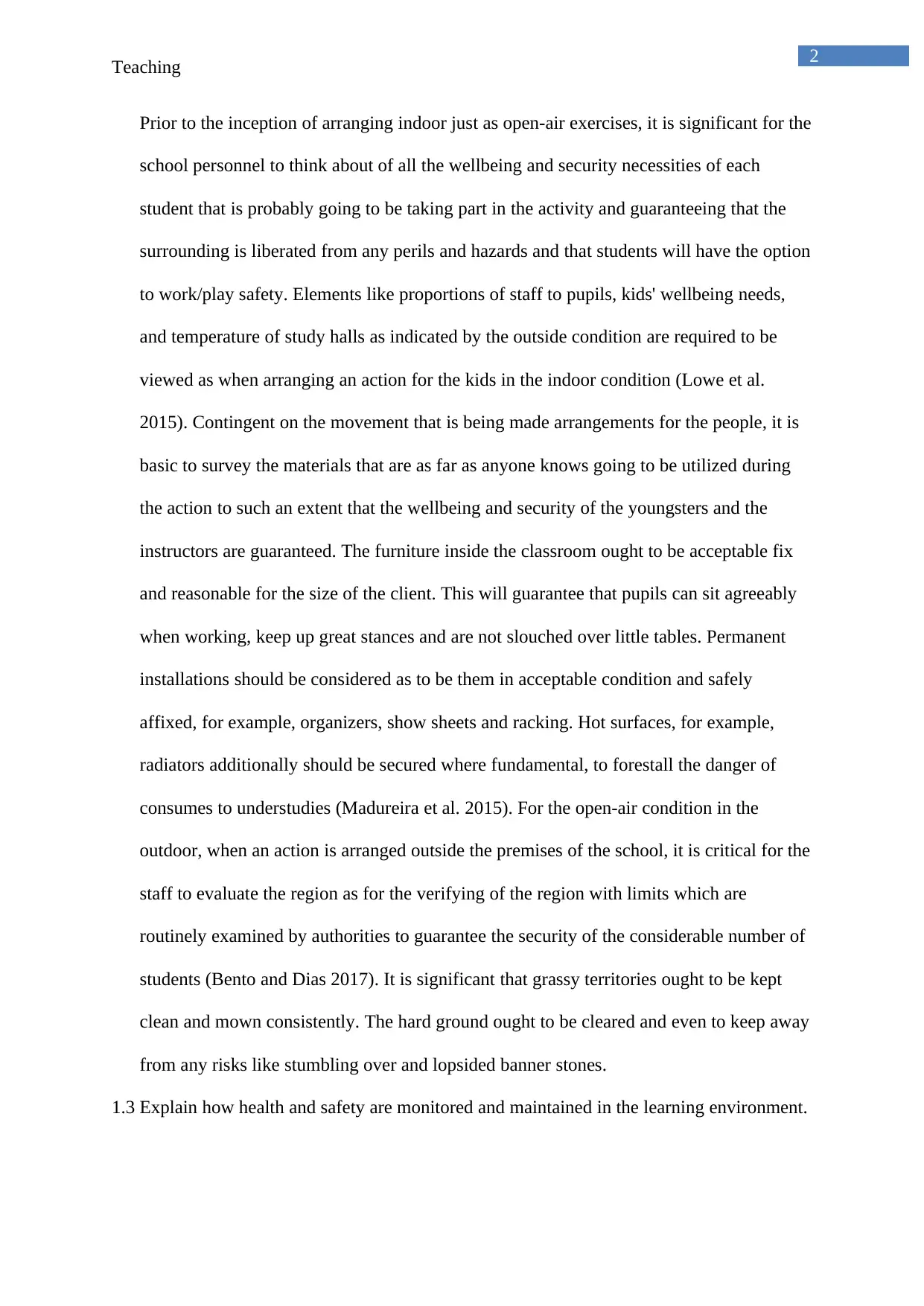
2
Teaching
Prior to the inception of arranging indoor just as open-air exercises, it is significant for the
school personnel to think about of all the wellbeing and security necessities of each
student that is probably going to be taking part in the activity and guaranteeing that the
surrounding is liberated from any perils and hazards and that students will have the option
to work/play safety. Elements like proportions of staff to pupils, kids' wellbeing needs,
and temperature of study halls as indicated by the outside condition are required to be
viewed as when arranging an action for the kids in the indoor condition (Lowe et al.
2015). Contingent on the movement that is being made arrangements for the people, it is
basic to survey the materials that are as far as anyone knows going to be utilized during
the action to such an extent that the wellbeing and security of the youngsters and the
instructors are guaranteed. The furniture inside the classroom ought to be acceptable fix
and reasonable for the size of the client. This will guarantee that pupils can sit agreeably
when working, keep up great stances and are not slouched over little tables. Permanent
installations should be considered as to be them in acceptable condition and safely
affixed, for example, organizers, show sheets and racking. Hot surfaces, for example,
radiators additionally should be secured where fundamental, to forestall the danger of
consumes to understudies (Madureira et al. 2015). For the open-air condition in the
outdoor, when an action is arranged outside the premises of the school, it is critical for the
staff to evaluate the region as for the verifying of the region with limits which are
routinely examined by authorities to guarantee the security of the considerable number of
students (Bento and Dias 2017). It is significant that grassy territories ought to be kept
clean and mown consistently. The hard ground ought to be cleared and even to keep away
from any risks like stumbling over and lopsided banner stones.
1.3 Explain how health and safety are monitored and maintained in the learning environment.
Teaching
Prior to the inception of arranging indoor just as open-air exercises, it is significant for the
school personnel to think about of all the wellbeing and security necessities of each
student that is probably going to be taking part in the activity and guaranteeing that the
surrounding is liberated from any perils and hazards and that students will have the option
to work/play safety. Elements like proportions of staff to pupils, kids' wellbeing needs,
and temperature of study halls as indicated by the outside condition are required to be
viewed as when arranging an action for the kids in the indoor condition (Lowe et al.
2015). Contingent on the movement that is being made arrangements for the people, it is
basic to survey the materials that are as far as anyone knows going to be utilized during
the action to such an extent that the wellbeing and security of the youngsters and the
instructors are guaranteed. The furniture inside the classroom ought to be acceptable fix
and reasonable for the size of the client. This will guarantee that pupils can sit agreeably
when working, keep up great stances and are not slouched over little tables. Permanent
installations should be considered as to be them in acceptable condition and safely
affixed, for example, organizers, show sheets and racking. Hot surfaces, for example,
radiators additionally should be secured where fundamental, to forestall the danger of
consumes to understudies (Madureira et al. 2015). For the open-air condition in the
outdoor, when an action is arranged outside the premises of the school, it is critical for the
staff to evaluate the region as for the verifying of the region with limits which are
routinely examined by authorities to guarantee the security of the considerable number of
students (Bento and Dias 2017). It is significant that grassy territories ought to be kept
clean and mown consistently. The hard ground ought to be cleared and even to keep away
from any risks like stumbling over and lopsided banner stones.
1.3 Explain how health and safety are monitored and maintained in the learning environment.
⊘ This is a preview!⊘
Do you want full access?
Subscribe today to unlock all pages.

Trusted by 1+ million students worldwide
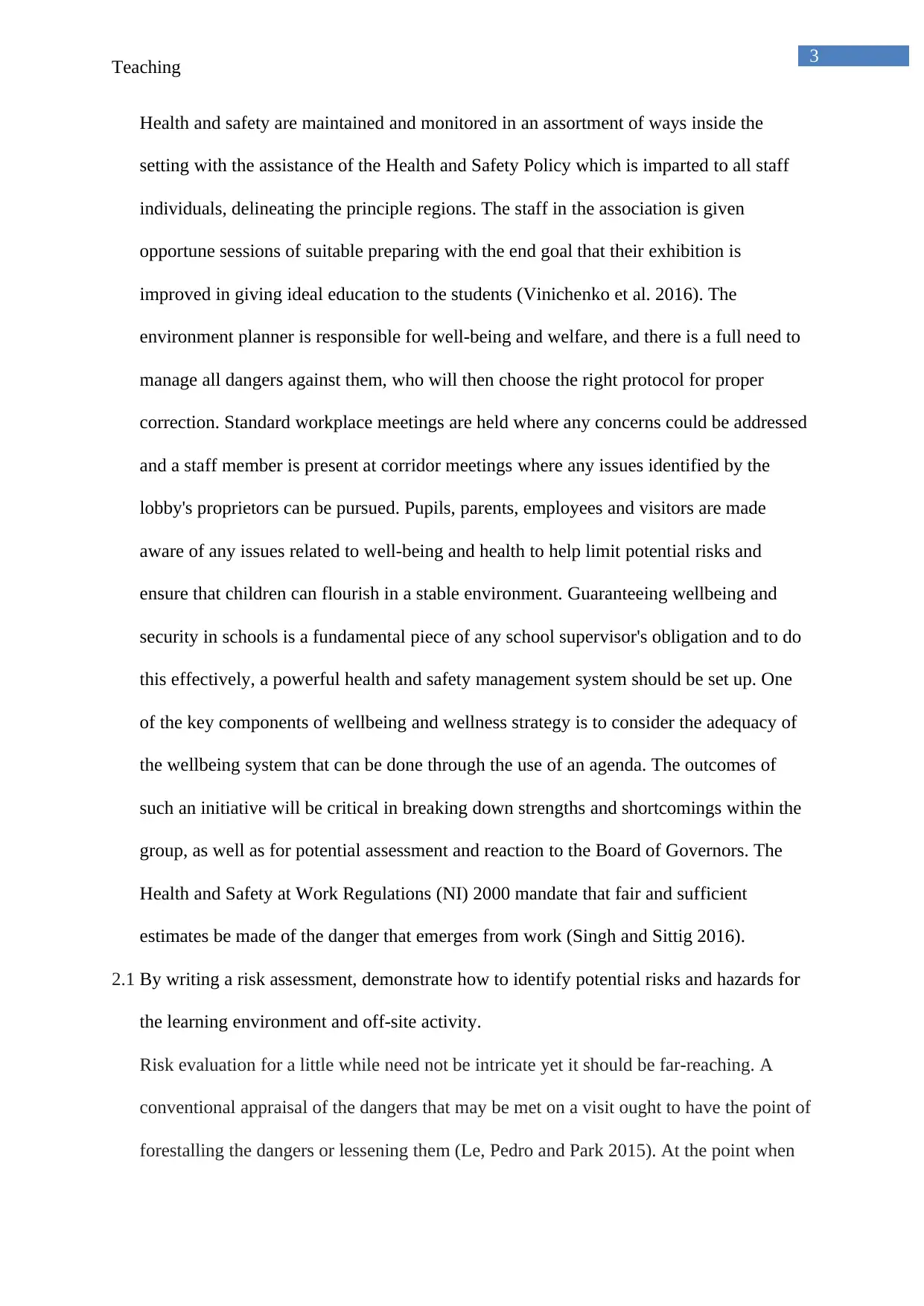
3
Teaching
Health and safety are maintained and monitored in an assortment of ways inside the
setting with the assistance of the Health and Safety Policy which is imparted to all staff
individuals, delineating the principle regions. The staff in the association is given
opportune sessions of suitable preparing with the end goal that their exhibition is
improved in giving ideal education to the students (Vinichenko et al. 2016). The
environment planner is responsible for well-being and welfare, and there is a full need to
manage all dangers against them, who will then choose the right protocol for proper
correction. Standard workplace meetings are held where any concerns could be addressed
and a staff member is present at corridor meetings where any issues identified by the
lobby's proprietors can be pursued. Pupils, parents, employees and visitors are made
aware of any issues related to well-being and health to help limit potential risks and
ensure that children can flourish in a stable environment. Guaranteeing wellbeing and
security in schools is a fundamental piece of any school supervisor's obligation and to do
this effectively, a powerful health and safety management system should be set up. One
of the key components of wellbeing and wellness strategy is to consider the adequacy of
the wellbeing system that can be done through the use of an agenda. The outcomes of
such an initiative will be critical in breaking down strengths and shortcomings within the
group, as well as for potential assessment and reaction to the Board of Governors. The
Health and Safety at Work Regulations (NI) 2000 mandate that fair and sufficient
estimates be made of the danger that emerges from work (Singh and Sittig 2016).
2.1 By writing a risk assessment, demonstrate how to identify potential risks and hazards for
the learning environment and off-site activity.
Risk evaluation for a little while need not be intricate yet it should be far-reaching. A
conventional appraisal of the dangers that may be met on a visit ought to have the point of
forestalling the dangers or lessening them (Le, Pedro and Park 2015). At the point when
Teaching
Health and safety are maintained and monitored in an assortment of ways inside the
setting with the assistance of the Health and Safety Policy which is imparted to all staff
individuals, delineating the principle regions. The staff in the association is given
opportune sessions of suitable preparing with the end goal that their exhibition is
improved in giving ideal education to the students (Vinichenko et al. 2016). The
environment planner is responsible for well-being and welfare, and there is a full need to
manage all dangers against them, who will then choose the right protocol for proper
correction. Standard workplace meetings are held where any concerns could be addressed
and a staff member is present at corridor meetings where any issues identified by the
lobby's proprietors can be pursued. Pupils, parents, employees and visitors are made
aware of any issues related to well-being and health to help limit potential risks and
ensure that children can flourish in a stable environment. Guaranteeing wellbeing and
security in schools is a fundamental piece of any school supervisor's obligation and to do
this effectively, a powerful health and safety management system should be set up. One
of the key components of wellbeing and wellness strategy is to consider the adequacy of
the wellbeing system that can be done through the use of an agenda. The outcomes of
such an initiative will be critical in breaking down strengths and shortcomings within the
group, as well as for potential assessment and reaction to the Board of Governors. The
Health and Safety at Work Regulations (NI) 2000 mandate that fair and sufficient
estimates be made of the danger that emerges from work (Singh and Sittig 2016).
2.1 By writing a risk assessment, demonstrate how to identify potential risks and hazards for
the learning environment and off-site activity.
Risk evaluation for a little while need not be intricate yet it should be far-reaching. A
conventional appraisal of the dangers that may be met on a visit ought to have the point of
forestalling the dangers or lessening them (Le, Pedro and Park 2015). At the point when
Paraphrase This Document
Need a fresh take? Get an instant paraphrase of this document with our AI Paraphraser
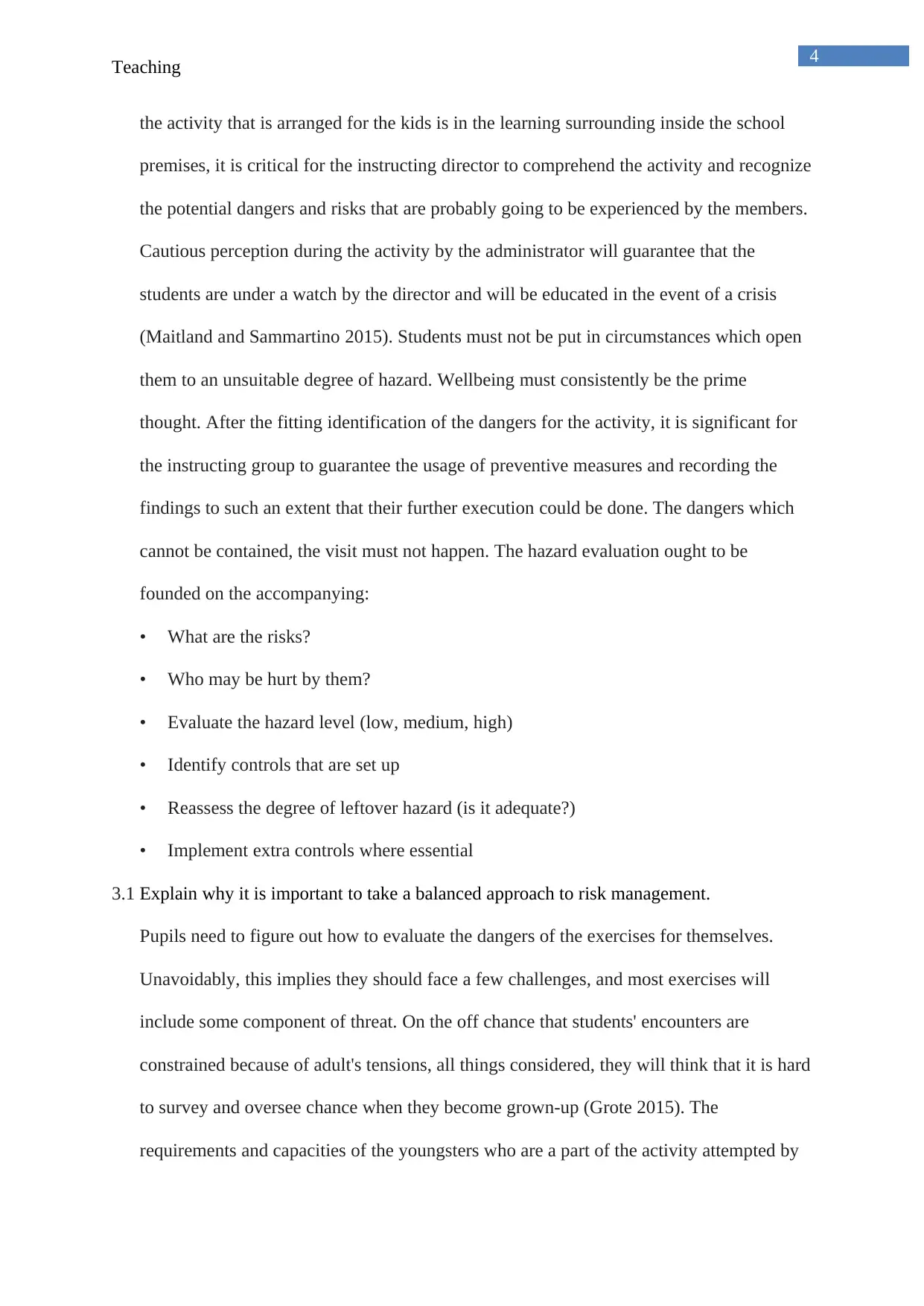
4
Teaching
the activity that is arranged for the kids is in the learning surrounding inside the school
premises, it is critical for the instructing director to comprehend the activity and recognize
the potential dangers and risks that are probably going to be experienced by the members.
Cautious perception during the activity by the administrator will guarantee that the
students are under a watch by the director and will be educated in the event of a crisis
(Maitland and Sammartino 2015). Students must not be put in circumstances which open
them to an unsuitable degree of hazard. Wellbeing must consistently be the prime
thought. After the fitting identification of the dangers for the activity, it is significant for
the instructing group to guarantee the usage of preventive measures and recording the
findings to such an extent that their further execution could be done. The dangers which
cannot be contained, the visit must not happen. The hazard evaluation ought to be
founded on the accompanying:
• What are the risks?
• Who may be hurt by them?
• Evaluate the hazard level (low, medium, high)
• Identify controls that are set up
• Reassess the degree of leftover hazard (is it adequate?)
• Implement extra controls where essential
3.1 Explain why it is important to take a balanced approach to risk management.
Pupils need to figure out how to evaluate the dangers of the exercises for themselves.
Unavoidably, this implies they should face a few challenges, and most exercises will
include some component of threat. On the off chance that students' encounters are
constrained because of adult's tensions, all things considered, they will think that it is hard
to survey and oversee chance when they become grown-up (Grote 2015). The
requirements and capacities of the youngsters who are a part of the activity attempted by
Teaching
the activity that is arranged for the kids is in the learning surrounding inside the school
premises, it is critical for the instructing director to comprehend the activity and recognize
the potential dangers and risks that are probably going to be experienced by the members.
Cautious perception during the activity by the administrator will guarantee that the
students are under a watch by the director and will be educated in the event of a crisis
(Maitland and Sammartino 2015). Students must not be put in circumstances which open
them to an unsuitable degree of hazard. Wellbeing must consistently be the prime
thought. After the fitting identification of the dangers for the activity, it is significant for
the instructing group to guarantee the usage of preventive measures and recording the
findings to such an extent that their further execution could be done. The dangers which
cannot be contained, the visit must not happen. The hazard evaluation ought to be
founded on the accompanying:
• What are the risks?
• Who may be hurt by them?
• Evaluate the hazard level (low, medium, high)
• Identify controls that are set up
• Reassess the degree of leftover hazard (is it adequate?)
• Implement extra controls where essential
3.1 Explain why it is important to take a balanced approach to risk management.
Pupils need to figure out how to evaluate the dangers of the exercises for themselves.
Unavoidably, this implies they should face a few challenges, and most exercises will
include some component of threat. On the off chance that students' encounters are
constrained because of adult's tensions, all things considered, they will think that it is hard
to survey and oversee chance when they become grown-up (Grote 2015). The
requirements and capacities of the youngsters who are a part of the activity attempted by
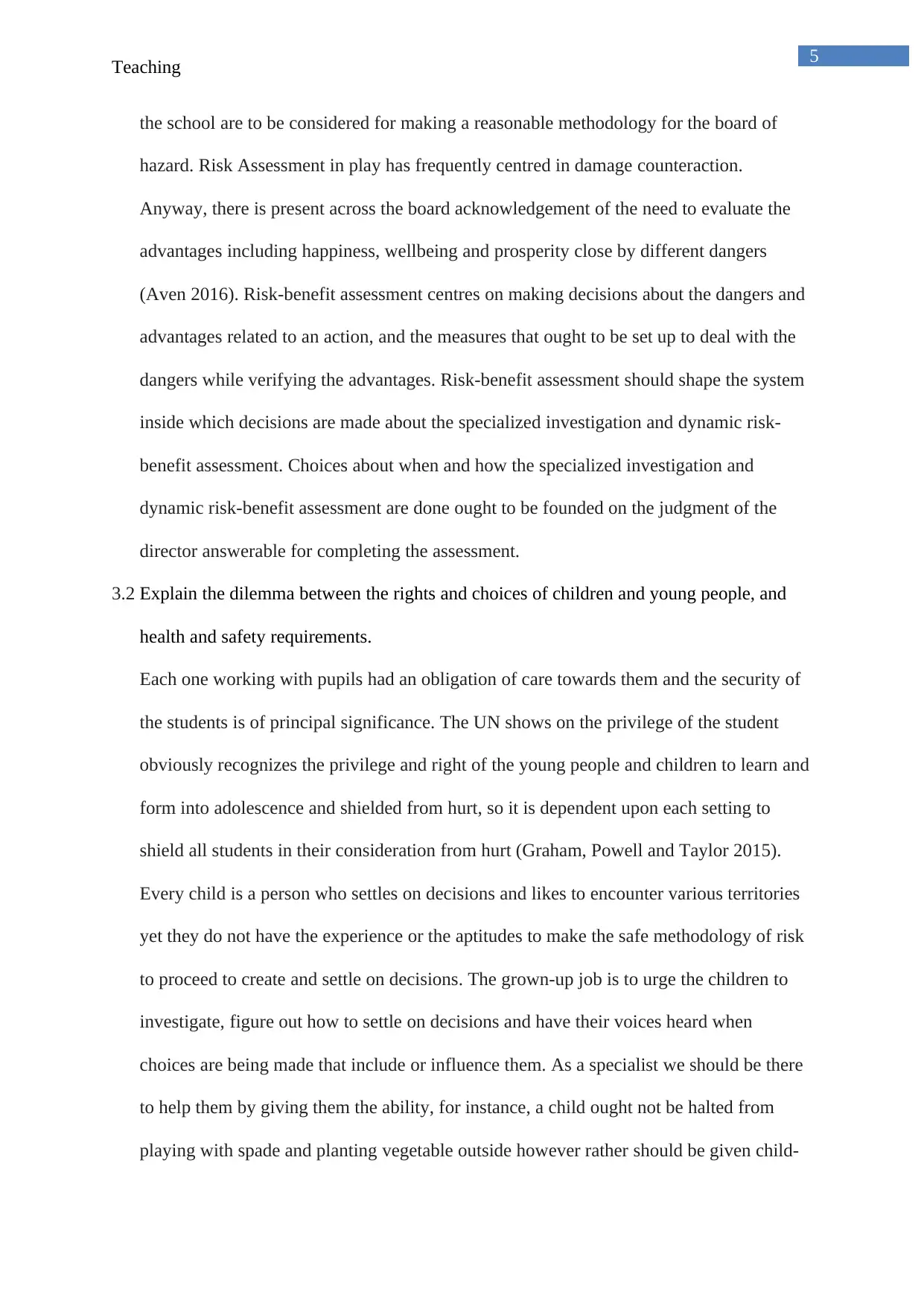
5
Teaching
the school are to be considered for making a reasonable methodology for the board of
hazard. Risk Assessment in play has frequently centred in damage counteraction.
Anyway, there is present across the board acknowledgement of the need to evaluate the
advantages including happiness, wellbeing and prosperity close by different dangers
(Aven 2016). Risk-benefit assessment centres on making decisions about the dangers and
advantages related to an action, and the measures that ought to be set up to deal with the
dangers while verifying the advantages. Risk-benefit assessment should shape the system
inside which decisions are made about the specialized investigation and dynamic risk-
benefit assessment. Choices about when and how the specialized investigation and
dynamic risk-benefit assessment are done ought to be founded on the judgment of the
director answerable for completing the assessment.
3.2 Explain the dilemma between the rights and choices of children and young people, and
health and safety requirements.
Each one working with pupils had an obligation of care towards them and the security of
the students is of principal significance. The UN shows on the privilege of the student
obviously recognizes the privilege and right of the young people and children to learn and
form into adolescence and shielded from hurt, so it is dependent upon each setting to
shield all students in their consideration from hurt (Graham, Powell and Taylor 2015).
Every child is a person who settles on decisions and likes to encounter various territories
yet they do not have the experience or the aptitudes to make the safe methodology of risk
to proceed to create and settle on decisions. The grown-up job is to urge the children to
investigate, figure out how to settle on decisions and have their voices heard when
choices are being made that include or influence them. As a specialist we should be there
to help them by giving them the ability, for instance, a child ought not be halted from
playing with spade and planting vegetable outside however rather should be given child-
Teaching
the school are to be considered for making a reasonable methodology for the board of
hazard. Risk Assessment in play has frequently centred in damage counteraction.
Anyway, there is present across the board acknowledgement of the need to evaluate the
advantages including happiness, wellbeing and prosperity close by different dangers
(Aven 2016). Risk-benefit assessment centres on making decisions about the dangers and
advantages related to an action, and the measures that ought to be set up to deal with the
dangers while verifying the advantages. Risk-benefit assessment should shape the system
inside which decisions are made about the specialized investigation and dynamic risk-
benefit assessment. Choices about when and how the specialized investigation and
dynamic risk-benefit assessment are done ought to be founded on the judgment of the
director answerable for completing the assessment.
3.2 Explain the dilemma between the rights and choices of children and young people, and
health and safety requirements.
Each one working with pupils had an obligation of care towards them and the security of
the students is of principal significance. The UN shows on the privilege of the student
obviously recognizes the privilege and right of the young people and children to learn and
form into adolescence and shielded from hurt, so it is dependent upon each setting to
shield all students in their consideration from hurt (Graham, Powell and Taylor 2015).
Every child is a person who settles on decisions and likes to encounter various territories
yet they do not have the experience or the aptitudes to make the safe methodology of risk
to proceed to create and settle on decisions. The grown-up job is to urge the children to
investigate, figure out how to settle on decisions and have their voices heard when
choices are being made that include or influence them. As a specialist we should be there
to help them by giving them the ability, for instance, a child ought not be halted from
playing with spade and planting vegetable outside however rather should be given child-
⊘ This is a preview!⊘
Do you want full access?
Subscribe today to unlock all pages.

Trusted by 1+ million students worldwide
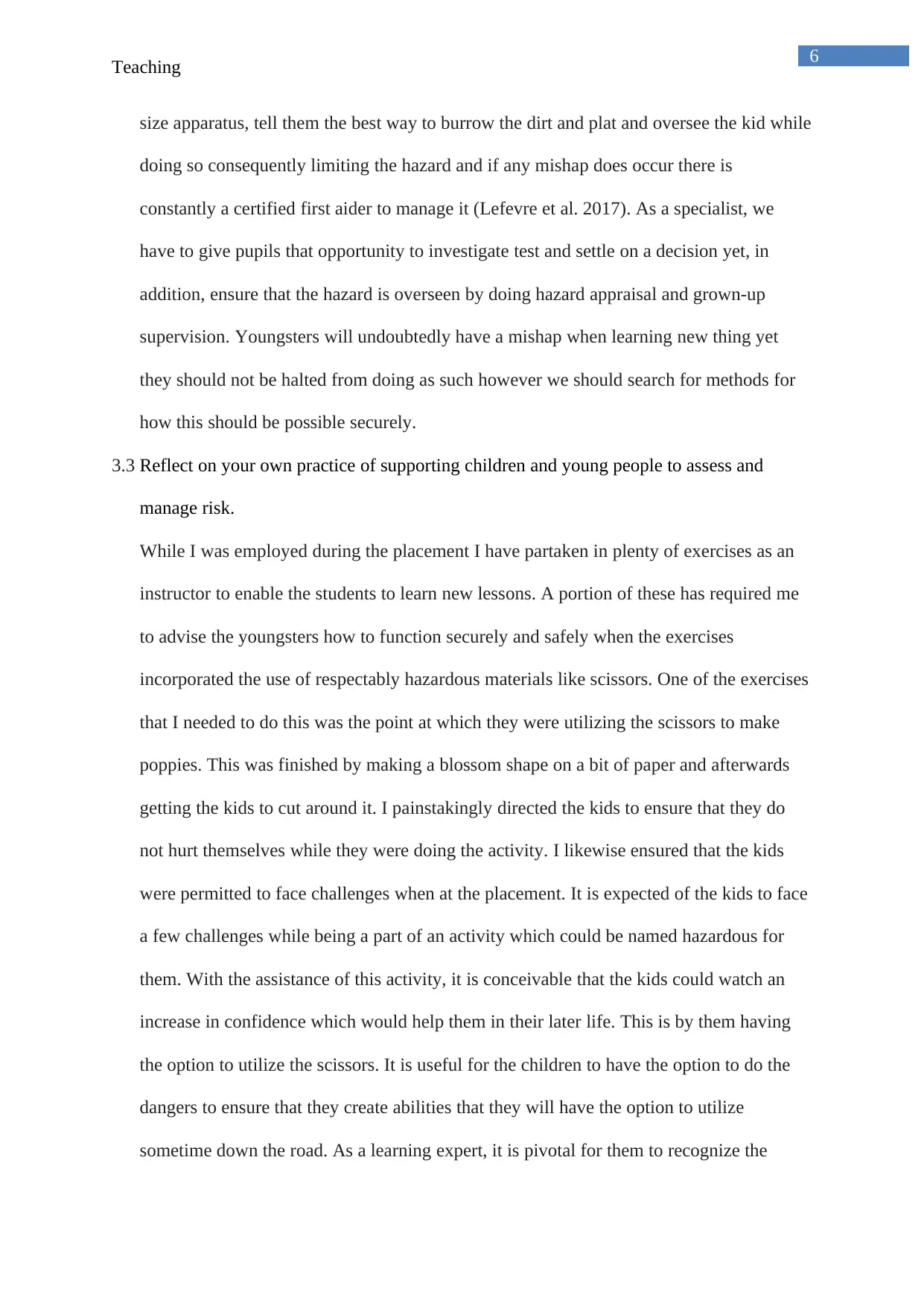
6
Teaching
size apparatus, tell them the best way to burrow the dirt and plat and oversee the kid while
doing so consequently limiting the hazard and if any mishap does occur there is
constantly a certified first aider to manage it (Lefevre et al. 2017). As a specialist, we
have to give pupils that opportunity to investigate test and settle on a decision yet, in
addition, ensure that the hazard is overseen by doing hazard appraisal and grown-up
supervision. Youngsters will undoubtedly have a mishap when learning new thing yet
they should not be halted from doing as such however we should search for methods for
how this should be possible securely.
3.3 Reflect on your own practice of supporting children and young people to assess and
manage risk.
While I was employed during the placement I have partaken in plenty of exercises as an
instructor to enable the students to learn new lessons. A portion of these has required me
to advise the youngsters how to function securely and safely when the exercises
incorporated the use of respectably hazardous materials like scissors. One of the exercises
that I needed to do this was the point at which they were utilizing the scissors to make
poppies. This was finished by making a blossom shape on a bit of paper and afterwards
getting the kids to cut around it. I painstakingly directed the kids to ensure that they do
not hurt themselves while they were doing the activity. I likewise ensured that the kids
were permitted to face challenges when at the placement. It is expected of the kids to face
a few challenges while being a part of an activity which could be named hazardous for
them. With the assistance of this activity, it is conceivable that the kids could watch an
increase in confidence which would help them in their later life. This is by them having
the option to utilize the scissors. It is useful for the children to have the option to do the
dangers to ensure that they create abilities that they will have the option to utilize
sometime down the road. As a learning expert, it is pivotal for them to recognize the
Teaching
size apparatus, tell them the best way to burrow the dirt and plat and oversee the kid while
doing so consequently limiting the hazard and if any mishap does occur there is
constantly a certified first aider to manage it (Lefevre et al. 2017). As a specialist, we
have to give pupils that opportunity to investigate test and settle on a decision yet, in
addition, ensure that the hazard is overseen by doing hazard appraisal and grown-up
supervision. Youngsters will undoubtedly have a mishap when learning new thing yet
they should not be halted from doing as such however we should search for methods for
how this should be possible securely.
3.3 Reflect on your own practice of supporting children and young people to assess and
manage risk.
While I was employed during the placement I have partaken in plenty of exercises as an
instructor to enable the students to learn new lessons. A portion of these has required me
to advise the youngsters how to function securely and safely when the exercises
incorporated the use of respectably hazardous materials like scissors. One of the exercises
that I needed to do this was the point at which they were utilizing the scissors to make
poppies. This was finished by making a blossom shape on a bit of paper and afterwards
getting the kids to cut around it. I painstakingly directed the kids to ensure that they do
not hurt themselves while they were doing the activity. I likewise ensured that the kids
were permitted to face challenges when at the placement. It is expected of the kids to face
a few challenges while being a part of an activity which could be named hazardous for
them. With the assistance of this activity, it is conceivable that the kids could watch an
increase in confidence which would help them in their later life. This is by them having
the option to utilize the scissors. It is useful for the children to have the option to do the
dangers to ensure that they create abilities that they will have the option to utilize
sometime down the road. As a learning expert, it is pivotal for them to recognize the
Paraphrase This Document
Need a fresh take? Get an instant paraphrase of this document with our AI Paraphraser
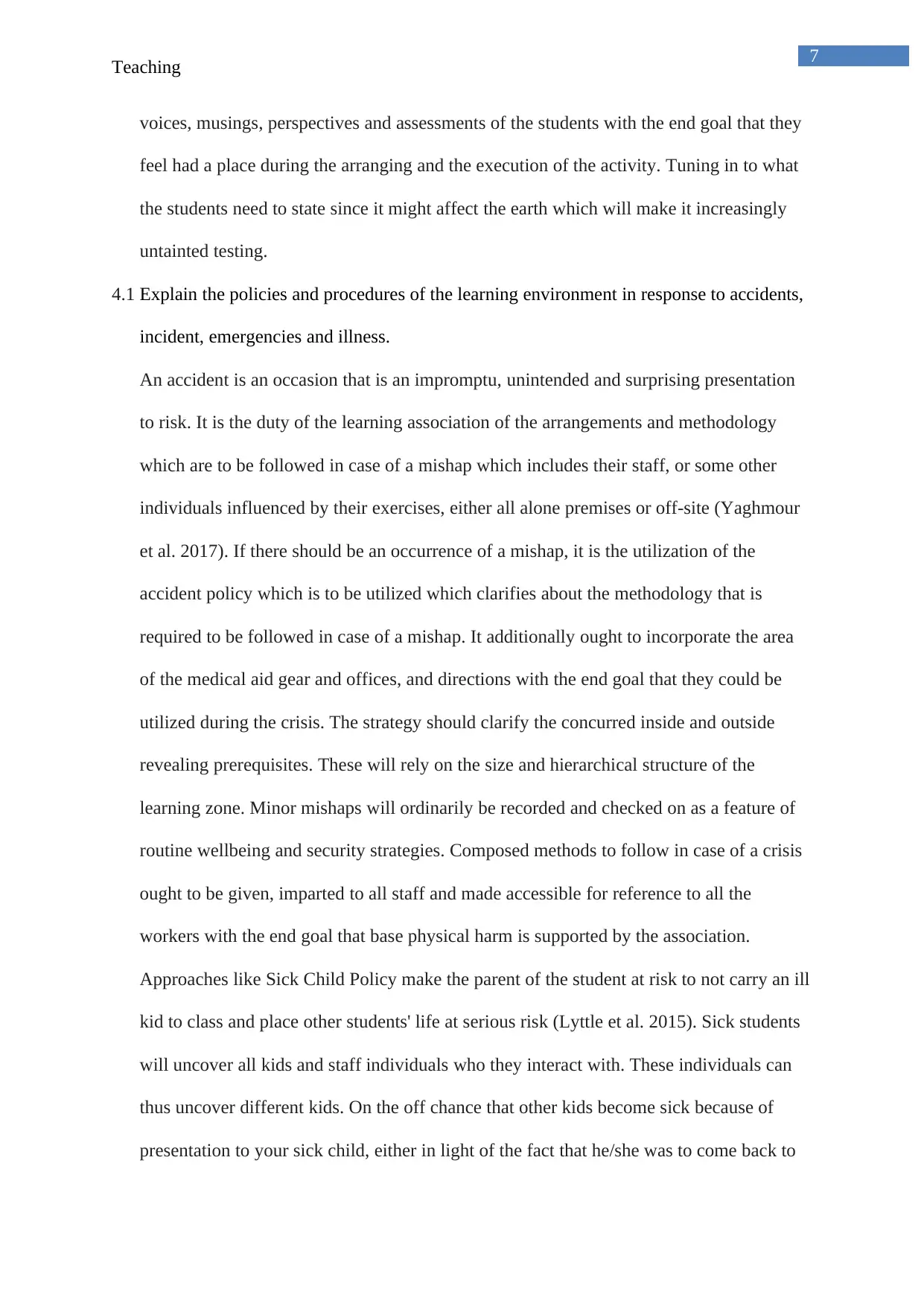
7
Teaching
voices, musings, perspectives and assessments of the students with the end goal that they
feel had a place during the arranging and the execution of the activity. Tuning in to what
the students need to state since it might affect the earth which will make it increasingly
untainted testing.
4.1 Explain the policies and procedures of the learning environment in response to accidents,
incident, emergencies and illness.
An accident is an occasion that is an impromptu, unintended and surprising presentation
to risk. It is the duty of the learning association of the arrangements and methodology
which are to be followed in case of a mishap which includes their staff, or some other
individuals influenced by their exercises, either all alone premises or off-site (Yaghmour
et al. 2017). If there should be an occurrence of a mishap, it is the utilization of the
accident policy which is to be utilized which clarifies about the methodology that is
required to be followed in case of a mishap. It additionally ought to incorporate the area
of the medical aid gear and offices, and directions with the end goal that they could be
utilized during the crisis. The strategy should clarify the concurred inside and outside
revealing prerequisites. These will rely on the size and hierarchical structure of the
learning zone. Minor mishaps will ordinarily be recorded and checked on as a feature of
routine wellbeing and security strategies. Composed methods to follow in case of a crisis
ought to be given, imparted to all staff and made accessible for reference to all the
workers with the end goal that base physical harm is supported by the association.
Approaches like Sick Child Policy make the parent of the student at risk to not carry an ill
kid to class and place other students' life at serious risk (Lyttle et al. 2015). Sick students
will uncover all kids and staff individuals who they interact with. These individuals can
thus uncover different kids. On the off chance that other kids become sick because of
presentation to your sick child, either in light of the fact that he/she was to come back to
Teaching
voices, musings, perspectives and assessments of the students with the end goal that they
feel had a place during the arranging and the execution of the activity. Tuning in to what
the students need to state since it might affect the earth which will make it increasingly
untainted testing.
4.1 Explain the policies and procedures of the learning environment in response to accidents,
incident, emergencies and illness.
An accident is an occasion that is an impromptu, unintended and surprising presentation
to risk. It is the duty of the learning association of the arrangements and methodology
which are to be followed in case of a mishap which includes their staff, or some other
individuals influenced by their exercises, either all alone premises or off-site (Yaghmour
et al. 2017). If there should be an occurrence of a mishap, it is the utilization of the
accident policy which is to be utilized which clarifies about the methodology that is
required to be followed in case of a mishap. It additionally ought to incorporate the area
of the medical aid gear and offices, and directions with the end goal that they could be
utilized during the crisis. The strategy should clarify the concurred inside and outside
revealing prerequisites. These will rely on the size and hierarchical structure of the
learning zone. Minor mishaps will ordinarily be recorded and checked on as a feature of
routine wellbeing and security strategies. Composed methods to follow in case of a crisis
ought to be given, imparted to all staff and made accessible for reference to all the
workers with the end goal that base physical harm is supported by the association.
Approaches like Sick Child Policy make the parent of the student at risk to not carry an ill
kid to class and place other students' life at serious risk (Lyttle et al. 2015). Sick students
will uncover all kids and staff individuals who they interact with. These individuals can
thus uncover different kids. On the off chance that other kids become sick because of
presentation to your sick child, either in light of the fact that he/she was to come back to
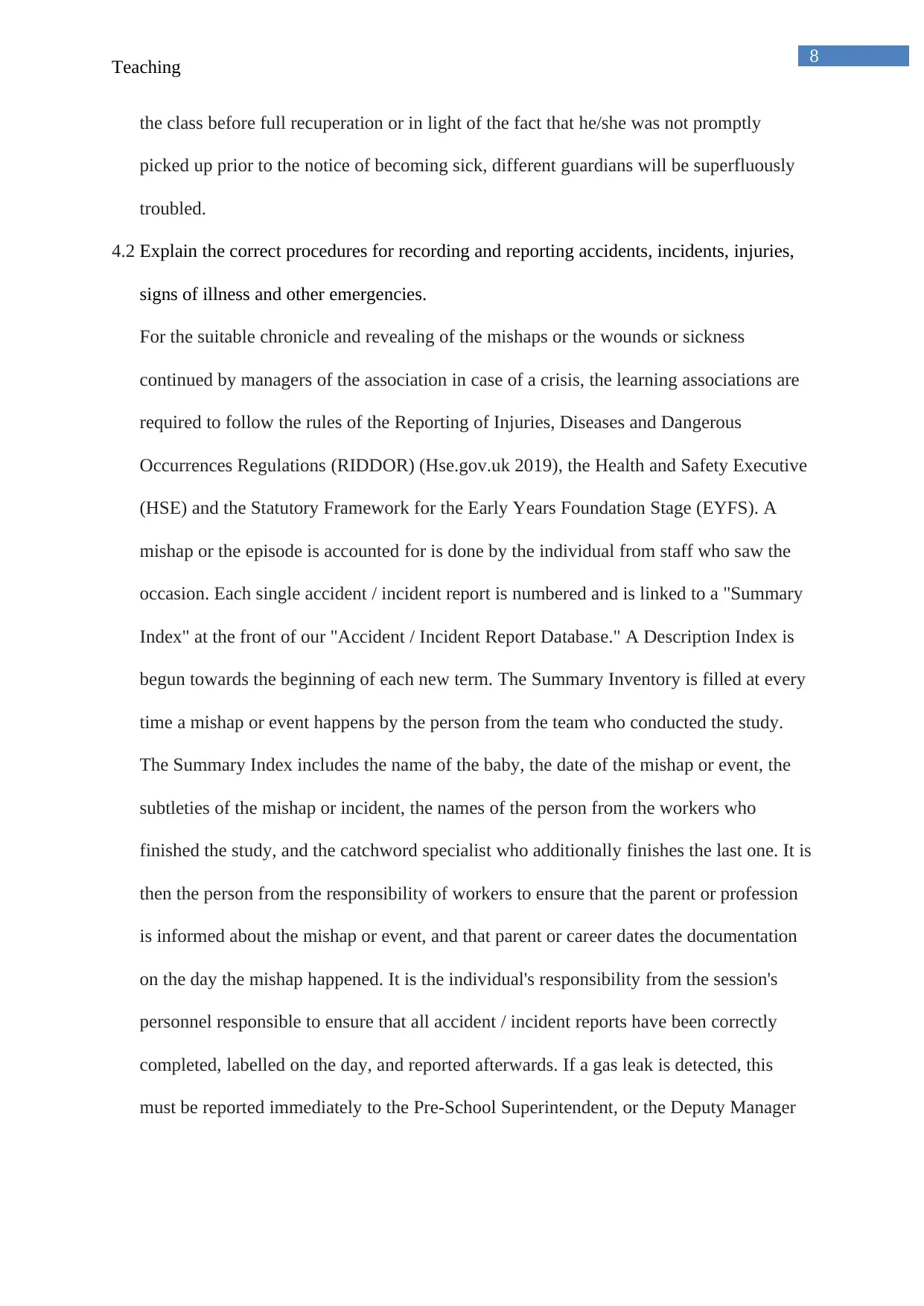
8
Teaching
the class before full recuperation or in light of the fact that he/she was not promptly
picked up prior to the notice of becoming sick, different guardians will be superfluously
troubled.
4.2 Explain the correct procedures for recording and reporting accidents, incidents, injuries,
signs of illness and other emergencies.
For the suitable chronicle and revealing of the mishaps or the wounds or sickness
continued by managers of the association in case of a crisis, the learning associations are
required to follow the rules of the Reporting of Injuries, Diseases and Dangerous
Occurrences Regulations (RIDDOR) (Hse.gov.uk 2019), the Health and Safety Executive
(HSE) and the Statutory Framework for the Early Years Foundation Stage (EYFS). A
mishap or the episode is accounted for is done by the individual from staff who saw the
occasion. Each single accident / incident report is numbered and is linked to a "Summary
Index" at the front of our "Accident / Incident Report Database." A Description Index is
begun towards the beginning of each new term. The Summary Inventory is filled at every
time a mishap or event happens by the person from the team who conducted the study.
The Summary Index includes the name of the baby, the date of the mishap or event, the
subtleties of the mishap or incident, the names of the person from the workers who
finished the study, and the catchword specialist who additionally finishes the last one. It is
then the person from the responsibility of workers to ensure that the parent or profession
is informed about the mishap or event, and that parent or career dates the documentation
on the day the mishap happened. It is the individual's responsibility from the session's
personnel responsible to ensure that all accident / incident reports have been correctly
completed, labelled on the day, and reported afterwards. If a gas leak is detected, this
must be reported immediately to the Pre-School Superintendent, or the Deputy Manager
Teaching
the class before full recuperation or in light of the fact that he/she was not promptly
picked up prior to the notice of becoming sick, different guardians will be superfluously
troubled.
4.2 Explain the correct procedures for recording and reporting accidents, incidents, injuries,
signs of illness and other emergencies.
For the suitable chronicle and revealing of the mishaps or the wounds or sickness
continued by managers of the association in case of a crisis, the learning associations are
required to follow the rules of the Reporting of Injuries, Diseases and Dangerous
Occurrences Regulations (RIDDOR) (Hse.gov.uk 2019), the Health and Safety Executive
(HSE) and the Statutory Framework for the Early Years Foundation Stage (EYFS). A
mishap or the episode is accounted for is done by the individual from staff who saw the
occasion. Each single accident / incident report is numbered and is linked to a "Summary
Index" at the front of our "Accident / Incident Report Database." A Description Index is
begun towards the beginning of each new term. The Summary Inventory is filled at every
time a mishap or event happens by the person from the team who conducted the study.
The Summary Index includes the name of the baby, the date of the mishap or event, the
subtleties of the mishap or incident, the names of the person from the workers who
finished the study, and the catchword specialist who additionally finishes the last one. It is
then the person from the responsibility of workers to ensure that the parent or profession
is informed about the mishap or event, and that parent or career dates the documentation
on the day the mishap happened. It is the individual's responsibility from the session's
personnel responsible to ensure that all accident / incident reports have been correctly
completed, labelled on the day, and reported afterwards. If a gas leak is detected, this
must be reported immediately to the Pre-School Superintendent, or the Deputy Manager
⊘ This is a preview!⊘
Do you want full access?
Subscribe today to unlock all pages.

Trusted by 1+ million students worldwide
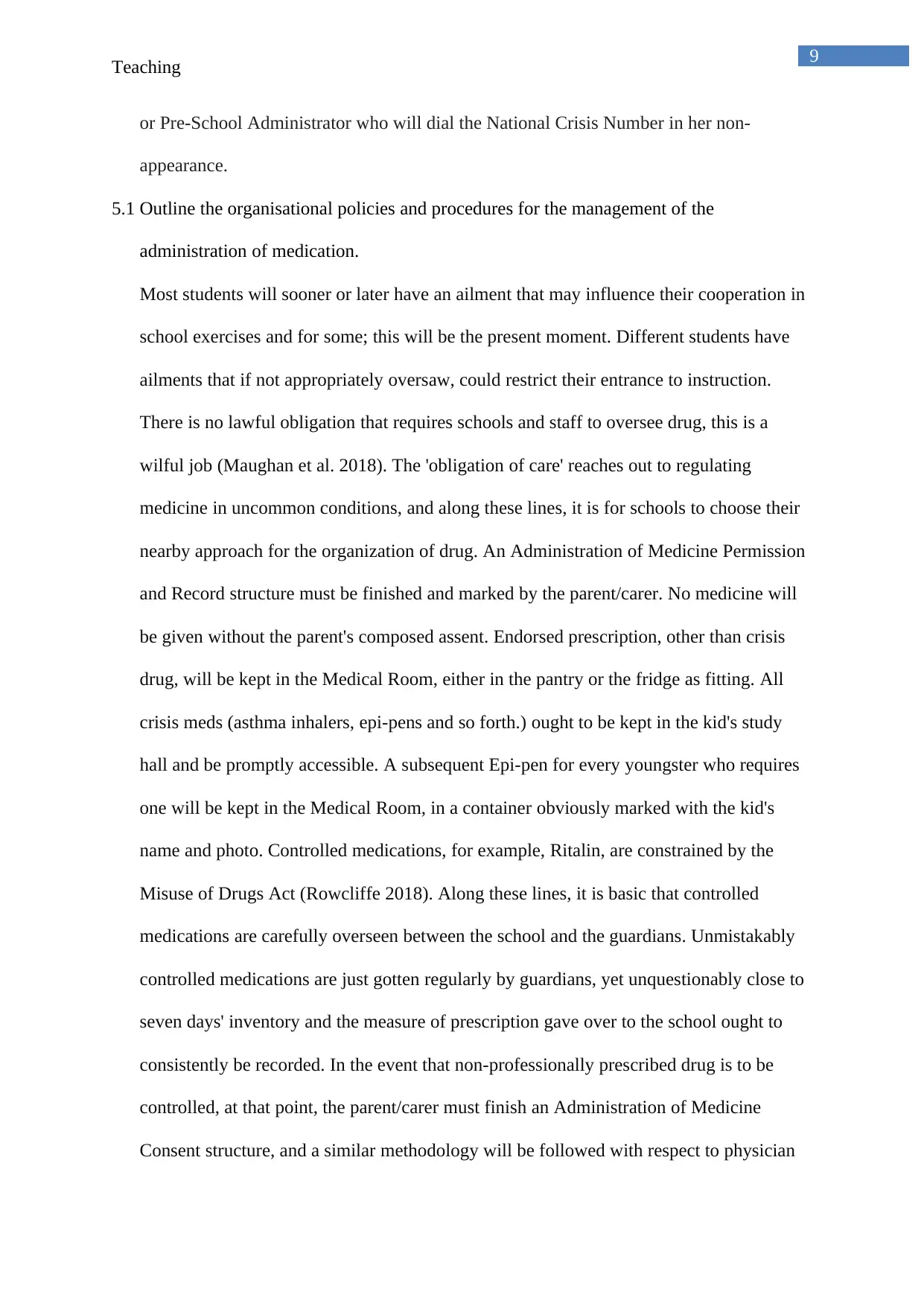
9
Teaching
or Pre-School Administrator who will dial the National Crisis Number in her non-
appearance.
5.1 Outline the organisational policies and procedures for the management of the
administration of medication.
Most students will sooner or later have an ailment that may influence their cooperation in
school exercises and for some; this will be the present moment. Different students have
ailments that if not appropriately oversaw, could restrict their entrance to instruction.
There is no lawful obligation that requires schools and staff to oversee drug, this is a
wilful job (Maughan et al. 2018). The 'obligation of care' reaches out to regulating
medicine in uncommon conditions, and along these lines, it is for schools to choose their
nearby approach for the organization of drug. An Administration of Medicine Permission
and Record structure must be finished and marked by the parent/carer. No medicine will
be given without the parent's composed assent. Endorsed prescription, other than crisis
drug, will be kept in the Medical Room, either in the pantry or the fridge as fitting. All
crisis meds (asthma inhalers, epi-pens and so forth.) ought to be kept in the kid's study
hall and be promptly accessible. A subsequent Epi-pen for every youngster who requires
one will be kept in the Medical Room, in a container obviously marked with the kid's
name and photo. Controlled medications, for example, Ritalin, are constrained by the
Misuse of Drugs Act (Rowcliffe 2018). Along these lines, it is basic that controlled
medications are carefully overseen between the school and the guardians. Unmistakably
controlled medications are just gotten regularly by guardians, yet unquestionably close to
seven days' inventory and the measure of prescription gave over to the school ought to
consistently be recorded. In the event that non-professionally prescribed drug is to be
controlled, at that point, the parent/carer must finish an Administration of Medicine
Consent structure, and a similar methodology will be followed with respect to physician
Teaching
or Pre-School Administrator who will dial the National Crisis Number in her non-
appearance.
5.1 Outline the organisational policies and procedures for the management of the
administration of medication.
Most students will sooner or later have an ailment that may influence their cooperation in
school exercises and for some; this will be the present moment. Different students have
ailments that if not appropriately oversaw, could restrict their entrance to instruction.
There is no lawful obligation that requires schools and staff to oversee drug, this is a
wilful job (Maughan et al. 2018). The 'obligation of care' reaches out to regulating
medicine in uncommon conditions, and along these lines, it is for schools to choose their
nearby approach for the organization of drug. An Administration of Medicine Permission
and Record structure must be finished and marked by the parent/carer. No medicine will
be given without the parent's composed assent. Endorsed prescription, other than crisis
drug, will be kept in the Medical Room, either in the pantry or the fridge as fitting. All
crisis meds (asthma inhalers, epi-pens and so forth.) ought to be kept in the kid's study
hall and be promptly accessible. A subsequent Epi-pen for every youngster who requires
one will be kept in the Medical Room, in a container obviously marked with the kid's
name and photo. Controlled medications, for example, Ritalin, are constrained by the
Misuse of Drugs Act (Rowcliffe 2018). Along these lines, it is basic that controlled
medications are carefully overseen between the school and the guardians. Unmistakably
controlled medications are just gotten regularly by guardians, yet unquestionably close to
seven days' inventory and the measure of prescription gave over to the school ought to
consistently be recorded. In the event that non-professionally prescribed drug is to be
controlled, at that point, the parent/carer must finish an Administration of Medicine
Consent structure, and a similar methodology will be followed with respect to physician
Paraphrase This Document
Need a fresh take? Get an instant paraphrase of this document with our AI Paraphraser
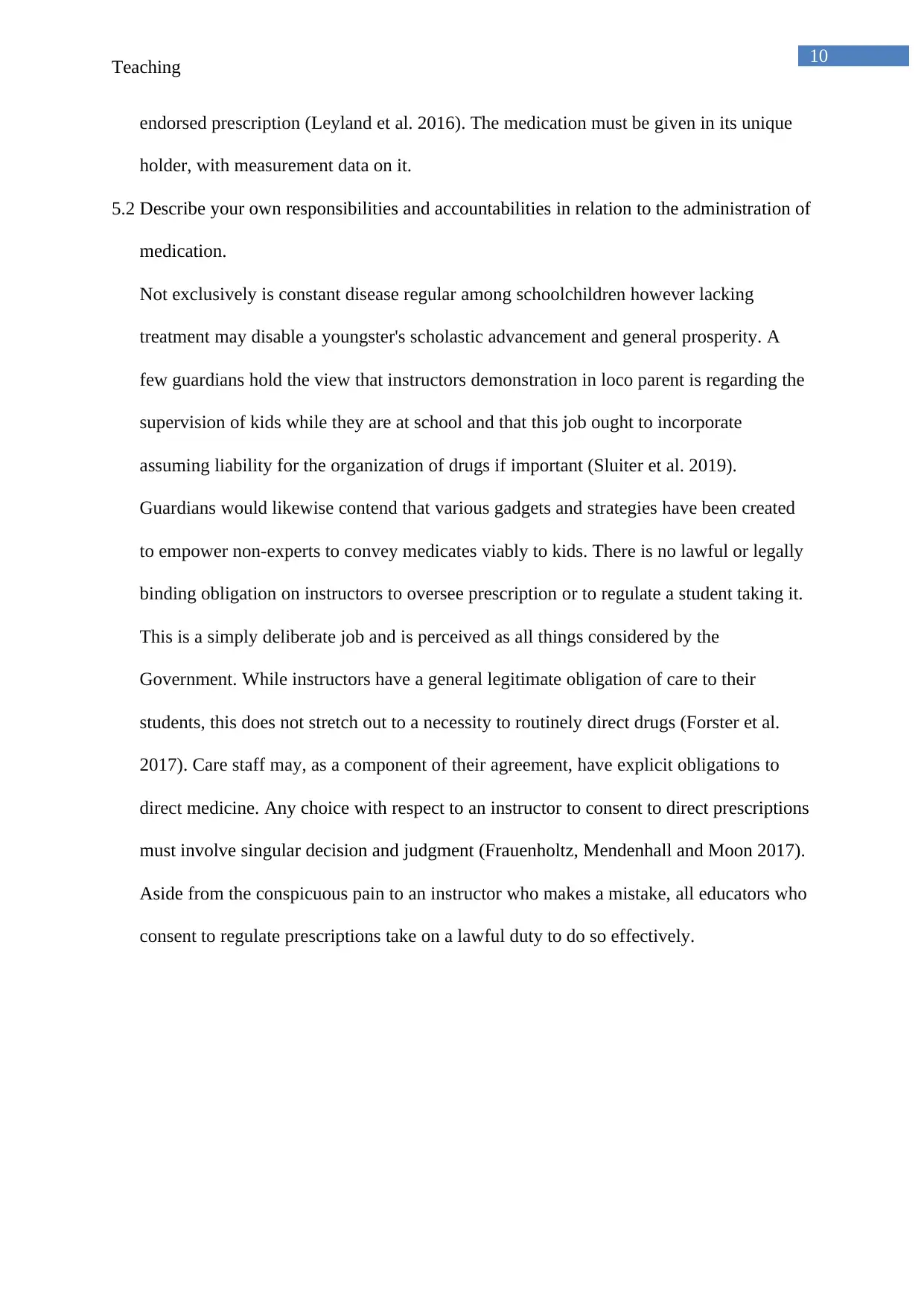
10
Teaching
endorsed prescription (Leyland et al. 2016). The medication must be given in its unique
holder, with measurement data on it.
5.2 Describe your own responsibilities and accountabilities in relation to the administration of
medication.
Not exclusively is constant disease regular among schoolchildren however lacking
treatment may disable a youngster's scholastic advancement and general prosperity. A
few guardians hold the view that instructors demonstration in loco parent is regarding the
supervision of kids while they are at school and that this job ought to incorporate
assuming liability for the organization of drugs if important (Sluiter et al. 2019).
Guardians would likewise contend that various gadgets and strategies have been created
to empower non-experts to convey medicates viably to kids. There is no lawful or legally
binding obligation on instructors to oversee prescription or to regulate a student taking it.
This is a simply deliberate job and is perceived as all things considered by the
Government. While instructors have a general legitimate obligation of care to their
students, this does not stretch out to a necessity to routinely direct drugs (Forster et al.
2017). Care staff may, as a component of their agreement, have explicit obligations to
direct medicine. Any choice with respect to an instructor to consent to direct prescriptions
must involve singular decision and judgment (Frauenholtz, Mendenhall and Moon 2017).
Aside from the conspicuous pain to an instructor who makes a mistake, all educators who
consent to regulate prescriptions take on a lawful duty to do so effectively.
Teaching
endorsed prescription (Leyland et al. 2016). The medication must be given in its unique
holder, with measurement data on it.
5.2 Describe your own responsibilities and accountabilities in relation to the administration of
medication.
Not exclusively is constant disease regular among schoolchildren however lacking
treatment may disable a youngster's scholastic advancement and general prosperity. A
few guardians hold the view that instructors demonstration in loco parent is regarding the
supervision of kids while they are at school and that this job ought to incorporate
assuming liability for the organization of drugs if important (Sluiter et al. 2019).
Guardians would likewise contend that various gadgets and strategies have been created
to empower non-experts to convey medicates viably to kids. There is no lawful or legally
binding obligation on instructors to oversee prescription or to regulate a student taking it.
This is a simply deliberate job and is perceived as all things considered by the
Government. While instructors have a general legitimate obligation of care to their
students, this does not stretch out to a necessity to routinely direct drugs (Forster et al.
2017). Care staff may, as a component of their agreement, have explicit obligations to
direct medicine. Any choice with respect to an instructor to consent to direct prescriptions
must involve singular decision and judgment (Frauenholtz, Mendenhall and Moon 2017).
Aside from the conspicuous pain to an instructor who makes a mistake, all educators who
consent to regulate prescriptions take on a lawful duty to do so effectively.
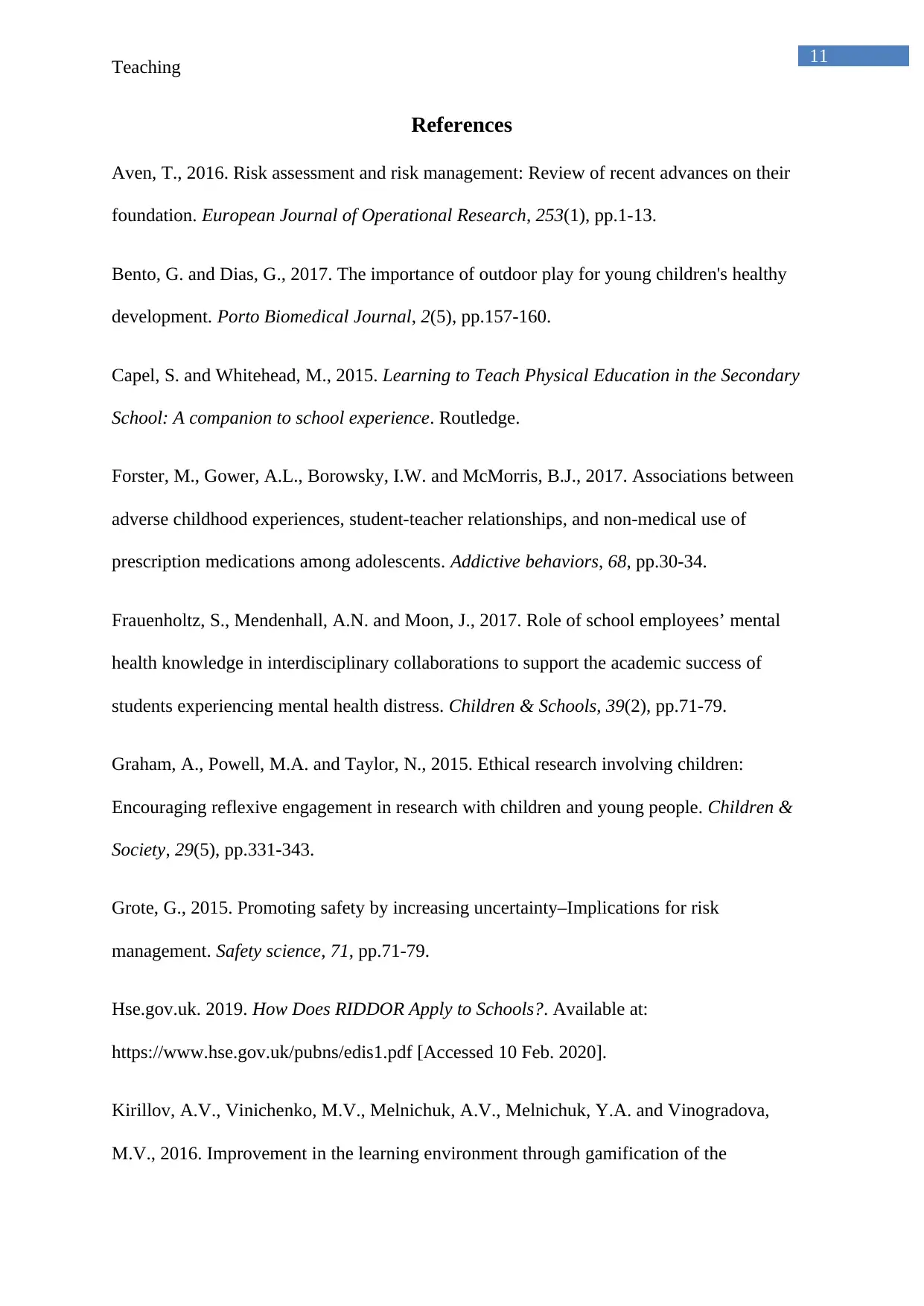
11
Teaching
References
Aven, T., 2016. Risk assessment and risk management: Review of recent advances on their
foundation. European Journal of Operational Research, 253(1), pp.1-13.
Bento, G. and Dias, G., 2017. The importance of outdoor play for young children's healthy
development. Porto Biomedical Journal, 2(5), pp.157-160.
Capel, S. and Whitehead, M., 2015. Learning to Teach Physical Education in the Secondary
School: A companion to school experience. Routledge.
Forster, M., Gower, A.L., Borowsky, I.W. and McMorris, B.J., 2017. Associations between
adverse childhood experiences, student-teacher relationships, and non-medical use of
prescription medications among adolescents. Addictive behaviors, 68, pp.30-34.
Frauenholtz, S., Mendenhall, A.N. and Moon, J., 2017. Role of school employees’ mental
health knowledge in interdisciplinary collaborations to support the academic success of
students experiencing mental health distress. Children & Schools, 39(2), pp.71-79.
Graham, A., Powell, M.A. and Taylor, N., 2015. Ethical research involving children:
Encouraging reflexive engagement in research with children and young people. Children &
Society, 29(5), pp.331-343.
Grote, G., 2015. Promoting safety by increasing uncertainty–Implications for risk
management. Safety science, 71, pp.71-79.
Hse.gov.uk. 2019. How Does RIDDOR Apply to Schools?. Available at:
https://www.hse.gov.uk/pubns/edis1.pdf [Accessed 10 Feb. 2020].
Kirillov, A.V., Vinichenko, M.V., Melnichuk, A.V., Melnichuk, Y.A. and Vinogradova,
M.V., 2016. Improvement in the learning environment through gamification of the
Teaching
References
Aven, T., 2016. Risk assessment and risk management: Review of recent advances on their
foundation. European Journal of Operational Research, 253(1), pp.1-13.
Bento, G. and Dias, G., 2017. The importance of outdoor play for young children's healthy
development. Porto Biomedical Journal, 2(5), pp.157-160.
Capel, S. and Whitehead, M., 2015. Learning to Teach Physical Education in the Secondary
School: A companion to school experience. Routledge.
Forster, M., Gower, A.L., Borowsky, I.W. and McMorris, B.J., 2017. Associations between
adverse childhood experiences, student-teacher relationships, and non-medical use of
prescription medications among adolescents. Addictive behaviors, 68, pp.30-34.
Frauenholtz, S., Mendenhall, A.N. and Moon, J., 2017. Role of school employees’ mental
health knowledge in interdisciplinary collaborations to support the academic success of
students experiencing mental health distress. Children & Schools, 39(2), pp.71-79.
Graham, A., Powell, M.A. and Taylor, N., 2015. Ethical research involving children:
Encouraging reflexive engagement in research with children and young people. Children &
Society, 29(5), pp.331-343.
Grote, G., 2015. Promoting safety by increasing uncertainty–Implications for risk
management. Safety science, 71, pp.71-79.
Hse.gov.uk. 2019. How Does RIDDOR Apply to Schools?. Available at:
https://www.hse.gov.uk/pubns/edis1.pdf [Accessed 10 Feb. 2020].
Kirillov, A.V., Vinichenko, M.V., Melnichuk, A.V., Melnichuk, Y.A. and Vinogradova,
M.V., 2016. Improvement in the learning environment through gamification of the
⊘ This is a preview!⊘
Do you want full access?
Subscribe today to unlock all pages.

Trusted by 1+ million students worldwide
1 out of 14
Related Documents
Your All-in-One AI-Powered Toolkit for Academic Success.
+13062052269
info@desklib.com
Available 24*7 on WhatsApp / Email
![[object Object]](/_next/static/media/star-bottom.7253800d.svg)
Unlock your academic potential
Copyright © 2020–2025 A2Z Services. All Rights Reserved. Developed and managed by ZUCOL.





